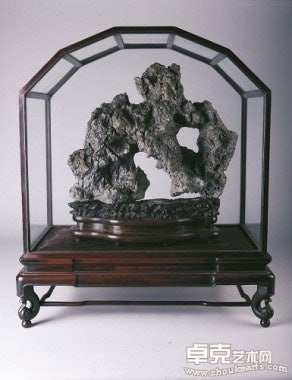Exhibition, "Objects of Contemplation: Natural Sculptures from the Qing Dynasty," Taking Place At The Henry Moore Institute, Leeds, Through March 7#

Although exhibitions of Chinese art in all its varied forms, from ancient sculptures to contemporary paintings, antique furniture to ice carvings, are popping up all over the world, some traditional Chinese arts simply don't get the exposure they perhaps deserve, owing to their esoteric nature, cultural incongruity, logistical challenges or a litany of other reasons. Currently, however, one of China's more unusual and mysterious art forms -- the natural sculptures known as "scholars' rocks" (供石) -- is on display at the Henry Moore Institute in Leeds, England, where a new exhibition presents these curious stones to what is undoubtedly a public that has had little opportunity to see and learn about many of China's older and more traditional art forms.
As an article in the Independent attests, the first reaction that many viewers have to scholars' rocks is something along the lines of, "what on earth is it?"
From the article:
You don't see that many of them in Western galleries, but their generic name is scholars' rocks, or sometimes viewing stones. They come from China and they may be from the 17th century or later. The idea is that they're natural rocks, of a particular quality, acquired by members of the intelligentsia, to be displayed on tables, for purposes that are enigmatic. Recently, they have started to be collected in the West. The British Museum has one – only one – and it's among the eight now showing in a small exhibition at the Henry Moore Institute in Leeds: Objects of Contemplation – Natural Sculptures from the Qing Dynasty. It's the most mysterious show I've seen in months.
Natural sculptures? They're all grouped together under the same glass box, like zoo or circus animals, bits of found nature on plinths. Some of them are stones with a wriggling, jagged, puckered texture. Some have more fluid bodies. Some of these so-called rocks are pieces of wood. One looks like a richly veined pebble, for example, but is actually petrified wood. Two were clearly branches. But whichever, the relationship between nature and sculpture – and between rocks and their bases – is complicated.
The rocks (or "rocks") are all authentic natural objects. It's important that they are. They're valued for forms that are not handmade. On the other hand, they are not random pickings. They're chosen according to human standards. They qualify as "fantastic rocks": something strange, special. And often, having been chosen, they're "completed" by human hand too, with a little improving carving. And finally – a further complication – the hand-finished object may be soaked in water to soften and renaturalise its surface. The desired effect is a combination of the irregular and regular, happy accident and hidden design.
...
There's a piece here, Jichimu Wood Sculpture in the Shape of an Eagle on a Rock, which is essentially a classy version of what the hobbyist makes. The Chinese craftsman has found a likeness, and worked the likeness up a bit into a nice bit of polished wood. Equally though, with no craft at all, arising simply from perception, there are countless mountains around the world named after what their shapes suggest.
Or if you want to get back up into higher art, think of Leonardo. He recommends artists to ponder on random damp patches on a wall, so as to get new ideas for compositions. Perhaps this is how the scholars' rocks can work. They needn't hold any specific lucky likeness. Rather, they could be opportunities for the free play of imagination. They're a 3D version of pictures in clouds and flames. You're to dwell on them, let the mind open.
With scholars' rocks, who knows? We may suspect that any sense of familiarity is misleading – or again, that that suspicion is itself misleading. These pieces enact a drama between nature and the human. Where it stands in the drama is hard to tell. (That's what makes it so fascinating.) Perhaps they display the amity between natural form and what the human hand can make. Perhaps these fantastic bits of stone and wood are points where nature shows itself in perfect tune with our tastes and imaginations.
Or is nature an alien? Is the point of these pieces a blank paradox, a category mistake? Nature is shown as if it were sculpture so we can see the difference between the meaningful and the meaningless. That was certainly the first impression: wild objects in captivity, tamed on pedestals, but beyond our ken.